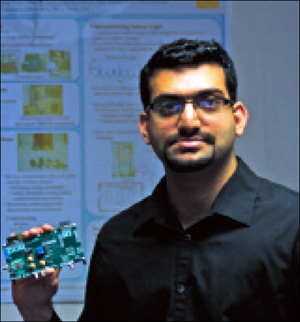Researchers at the U.K.’s Nottingham Trent University have invented a method of embedding radio frequency identification tags into yarn, which can then be woven or knitted to make fabric for clothing. “The technology will lead to the integration of electronic textiles into the Internet of Things and, ultimately, clothing-based wearable computing,” says Tilak Dias, a professor at the university’s Advanced Textiles Research Group of the School of Art & Design, who heads the team. “Clothing and other textile products will be able to sense, monitor and record changes in their surroundings and respond appropriately.”
The team used NXP Semiconductors‘ Ucode G2XM RFID chips (other chips could be used as well) and integrated short, thin copper strands attached to either side of each chip into the yarn fibers to act as an antenna. The chip and antenna are invisible to the naked eye. The chips are sealed in resin micropods within yarns, so the smart fabrics can be run through washing machines and tumble driers without being damaged. The technology would add only a few cents to the cost of an apparel item. More than one transponder can be added to increase a garment’s identifiability.
Dias sees potential applications in the retail industry, which could use transponders in clothing for supply-chain tracking and in-store theft reduction. Unlike electronic article surveillance (EAS) tags and conventional RFID transponders, which thieves can remove, embedded tags would be impossible to find.
This technology also might have applications in sports and health care. Tiny sensors attached to RFID transponders could provide constant data on a person’s heartbeat, temperature, perspiration and so on. “In addition to clothing, sensors in textile-based composites could provide lifetime monitoring of structures in the automotive and aerospace industries,” Dias says.
Privacy, Dias adds, will not be an issue, because the tags contain only a serial number and users can set them to be read at relatively short range. The research was supported by Sustainable Society Network+. Dias declined to say if any clothing manufacturers have been involved in the research, citing confidentiality agreements.
The team has secured a patent on electronically active yarns. The researchers are now developing a prototype production machine to make smart fabrics, and they are seeking potential partners to help commercialize the technology. Dias believes smart fabrics will be used in myriad ways, just as RFID and the Internet of Things has spawned widespread innovation.


